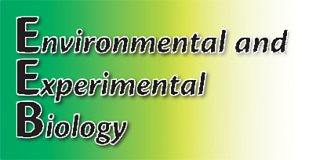
On-line: ISSN 2255–9582

| Faculty of Biology, University of Latvia | ||||||

|
Hard copy: ISSN 1691–8088
On-line: ISSN 2255–9582 Env Exp Biol (2013) 11: 23–38
|
|||||

|
About the Journal | Retractions | Open Access | Author Guidlines | Current Issue | Archive |
|
Environmental and Experimental Biology |
Env Exp Biol (2013) 11: 23–38 |
The aim of the study was to characterize soil microbial communities of nine conifer (Pinus sylvestris, Picea abies) stands mainly on podzolic soils, e.a., seven healthy stands (28 to 160 years) and two stands infected with root rot fungus Heterobasidion annosum s.l. (50 and 56 years). The studied microbial variables differed for healthy conifer stands on automorphic soils vs. infected conifer stands on semihydromorphic soils, and differed depending on forest age. Automorphic soils had significantly higher numbers of filamentous fungi in the upper soil layert han in the deeper layer. In semihydromorphic soils both analyzed soil layers had similar numbers of fungal colony-forming units. The pine stand had significantly lower yeast and maltose-utilizing bacteria density in the 11 to 30 cm soil layer. Sampling plots on semihydromorphic soils including infected stands lacked species of the Mortierella genus or had them in low percentage, but had increased percentage of colony-forming units of Umbelopsis genus. Semihydromorphic soils had decreased proportion of colony-forming units of Penicillium spp. and almost no Trichoderma spp. Molecular biology analysis showed that the average fungal diversity indice H’ in automorphic soils was significantly higher than in semihydromorphic soils. The highest fungal diversity in respect to represented genera was in the oldest sampling plot (16 genera). Antagonism assay of 52 Penicillium spp. isolates showed reduced growth rate of H. annosum s.l. but the antagonistic effect was not as strong as it has been reported for Trichoderma spp.